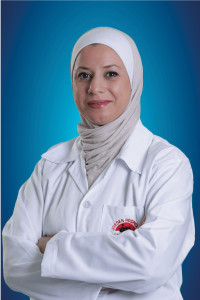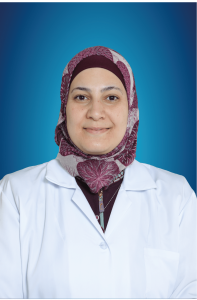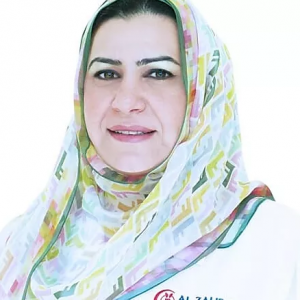Uterine Myoma
What is Uterine Myoma? Uterine myoma is also called leiomyoma or uterine fibroid. It is a growth in or around the uterus. It is a benign (non-cancerous) growth or neoplasm found along the uterine lining. Uterine myomas are common in women of childbearing age but can vary in size. Some do not experience any symptoms… Read More
Top Doctors For Uterine Myoma Treatments
Top Hospitals For Uterine Myoma Treatments
Uterine Myoma
What is Uterine Myoma?
Uterine myoma is also called leiomyoma or uterine fibroid. It is a growth in or around the uterus. It is a benign (non-cancerous) growth or neoplasm found along the uterine lining. Uterine myomas are common in women of childbearing age but can vary in size. Some do not experience any symptoms while some may experience pains and bleeding.
Uterine myomas appear in different sizes and numbers. They can present as a cluster or a single growth, as large as grapefruits or big enough to fill the pelvic or uterine cavity. Where they are very large, they can give the appearance of pregnancy, but this is ruled out during a pelvic examination or ultrasound. In some other cases, they appear too tiny and do not cause any problems.
What Causes Uterine Fibroids or Myomas to Grow?
It is unclear what causes uterine fibroids to grow, but they have been linked to changes in the oestrogen-progesterone balance. Fibroids are a very common type of growth, occurring in about 40%-80% of women. They are more common in women between 30-50 years of age. People who have not had their first menstrual cycle typically do not have fibroids. They are also less common in women who have entered menopause.
Certain risk factors have been linked to the development of uterine myomas, and they include the following:
- Race: The occurrence of fibroids is more common in women of African descent than in other ethnicities or races.
- Age and Parity: It is rare in women below the age of 20. Women who start menstruating early and those who reach menopause later are at higher risk. Pregnancy leads to changes in the uterus which affects fibroid growth. Childbirth usually results in the decrease or disappearance of some fibroids. Women who have not experienced this are at a higher risk of developing fibroids.
- Family history: A family history of uterine fibroids indicates a higher risk of growing fibroids among women in that family.
- Hormones: Changes in hormones like oestrogen, progesterone, and growth hormones have been linked to fibroid growth, especially oestrogen.
- Weight: Obese women and people who consume more red meat and take little or no green vegetables are more at risk. Obesity leads to an increase in oestrogen levels which favours fibroid growth.
Types of Uterine Myomas
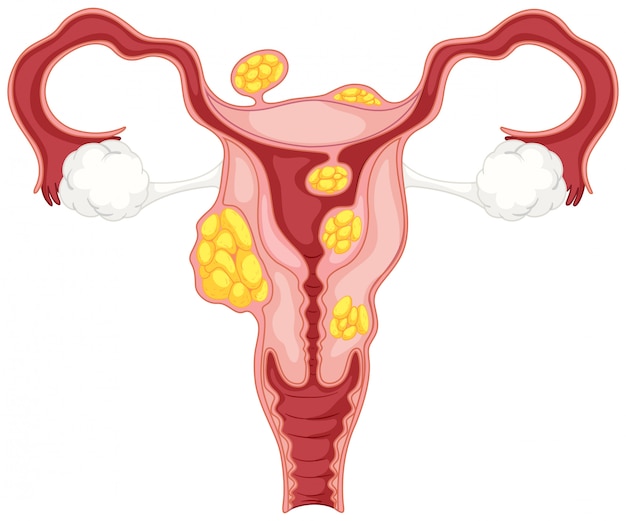
Uterine myomas are classified based on where they appear in or on the uterine walls. Some specific types of uterine fibroids include:
- Intramural fibroids – These are embedded into the muscular wall of the uterus. They are the most common types.
- Submucosal fibroids – These fibroids grow under the inner lining of the uterus.
- Subserosal fibroids – Under the uterine outer surface’s lining, subserosal fibroids proliferate. They can also become very large and grow into the individual’s pelvis.
- Pedunculated fibroids – These are the least common types. They attach to the uterus with a stem, often described as mushroom-like due to their stalk and wider top.
What are the symptoms of uterine fibroids?
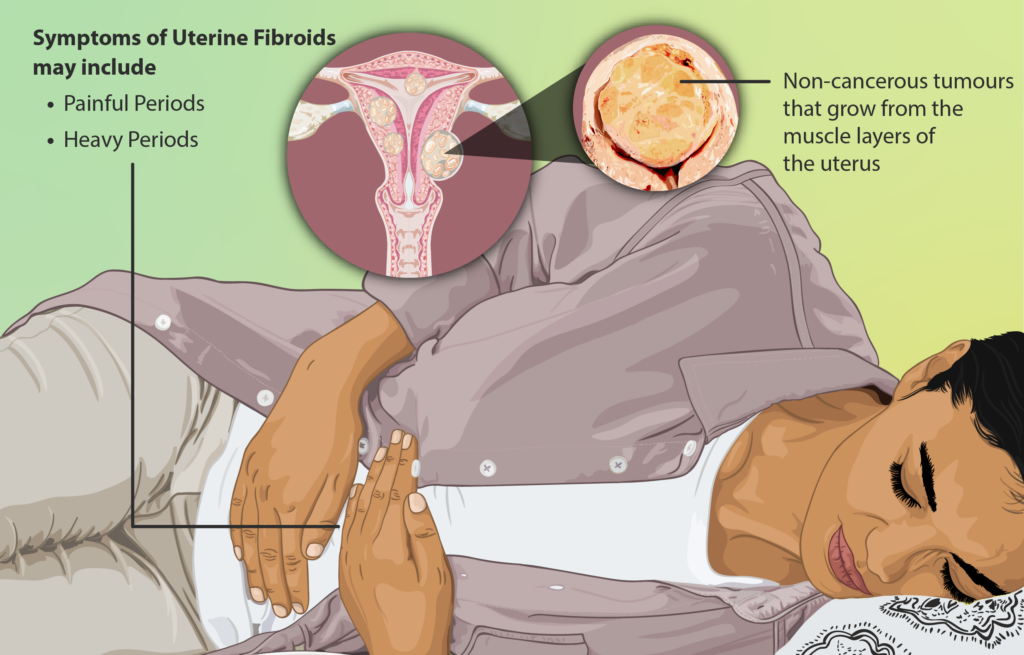
Most small fibroids do not cause any symptoms, and since they go unnoticed, they do not require any treatment. Larger fibroids can lead to a variety of symptoms including the following:
- Excessive or painful bleeding during the menstrual cycle
- Bloating or a feeling of fullness in the lower belly
- Frequent urination due to pressure of the fibroid on the bladder
- Pain during sex
- Lower back pain
- Inability to pee or empty the bladder
- Bleeding between the menstrual periods
- Increased distension of the abdomen
- Constipation
Due to the hormonal levels declining during menopause, the symptoms of uterine fibroids usually stabilize or go away.
What are the complications of fibroids?
Most uterine fibroids do not cause any severe complications, but the most common complications include:
- Pain that tends to become unmanageable
- Anemia
- Excessive bleeding
- Infertility
How are uterine fibroids diagnosed?
In most cases, they are discovered during a pelvic examination. In other cases, the heavy bleeding and other symptoms may alert the healthcare provider to its presence. Some tests can be carried out to confirm fibroids and determine their size and location. These tests can include:
- Ultrasonography
- Magnetic resonance imaging
- Computed tomography scan
- Hysteroscopy
- Hysterosalpingography
- Sonohysterography
- Laparoscopy
How are uterine fibroids treated?
The treatment can vary depending on the size, the number and their location, as well as the symptoms that they are eliciting. When they are not causing any symptoms, they are left alone and monitored. The best treatment options are also dependent on if the individual wants to get pregnant in the future. Some of the treatment options can include medication, surgery or both.
What types of medication are used?
Some of the medications that can be used to manage fibroids include:
- Over-the-counter pain medications
- Iron supplements
- Birth control
- Gonadotropin-releasing hormone agonists
- Oral therapies like Elagolix or tranexamic acids
Fibroid surgery
Several factors are considered when talking about the different types of surgery for fibroid removal. Some surgical options preserve the uterus and allow for future pregnancy while others can damage or remove the uterus entirely. Myomectomy is a procedure that allows for the removal of fibroids. There are several types of myomectomy, and they include:
- Hysteroscopy – This is a procedure where a scope is inserted through the vagina and cervix into the uterus, and it is used to cut away and remove the uterine myoma.
- Laparoscopy – This procedure also uses a scope to remove the fibroids. However, unlike hysteroscopy, a few cuts are placed in the abdomen to insert the scope.
- Laparotomy – A larger incision is made in the abdomen, and the fibroids are removed through this cut.
In the case that the woman is not planning any future pregnancies, some additional surgeries that can be done include:
- Hysterectomy – This is the removal of the uterus. It is the only way to permanently cure fibroids. If the ovaries are left in place, the woman does not go into menopause. This procedure can be recommended if the individual is experiencing heavy bleeding or if they have large fibroids. Minimally invasive hysterectomies include vaginal, laparoscopic or robotic methods.
- Uterine fibroid embolization – A small catheter is placed in the uterine artery or radial artery. Then small particles are injected. These particles then block the flow of blood from the artery into the fibroids. These then shrink the fibroids and improve the symptoms.
- Radiofrequency ablation (RFA) – This is a safe and effective treatment that uses microwave energy to treat uterine fibroids. It treats smaller fibroids and is recommended for individuals who have not reached menopause.

